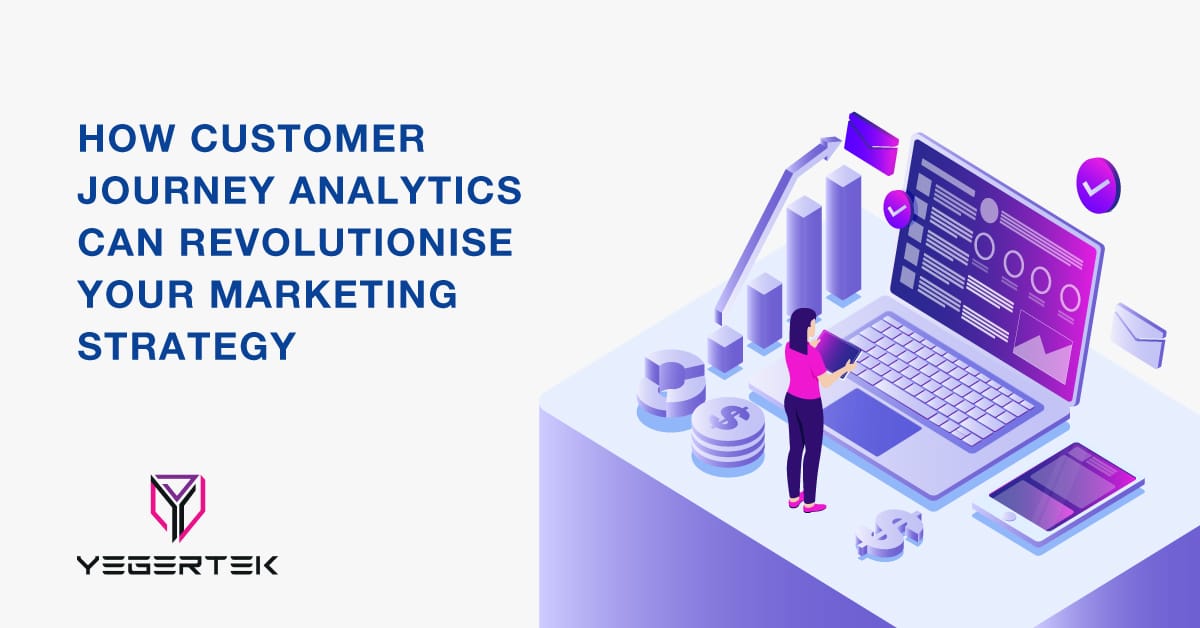
In a study conducted by Epsilon in 2023, it was found that about 80% of consumers are likely to engage with a brand if they offer a personalised experience. This brings us to the pressing question – what drives customer interactions?
Is it the user experience? or the reward options that they receive on making the purchase? In a world where consumers interact with businesses through multiple channels, understanding the entire customer journey has become more crucial than ever.
In this guide, we will understand how customer journey analytics (CJA) and customer engagement and experience platform (CEXP) paired with powerful CRM and loyalty tools can help businesses elevate their marketing efforts. But first, let’s take a look at what CJA is all about and why it’s crucial for creating impactful, data-driven experiences.
What is customer journey analytics, and how is it related to CEXP?
“Without data, you’re just another person with an opinion.”
– W. Edwards Deming.
Customer journey analytics involves the collection and analysis of dynamic data from different points of customer interaction throughout the user journey. This usually includes getting insights from interactions on different channels like websites, emails, customer service, social media, and much more.
Customer journey analytics and customer experience are closely related concepts and often work together in improving customer perspective and interactions. CJA gives businesses a holistic view of the customer’s journey, helping them identify pain points and enhance engagements. CEXP utilises the insights offered by customer journey analytics to create loyalty programs with a personal touch and help businesses keep their messaging and experiences consistent across different channels, both digital and physical.
With CJA, businesses get to –
- Understand the challenges and drop-offs faced by customers in their journey.
- Tailor the experiences, like targeted promotions, relevant suggestions, etc.
- Offer proactive resolutions for issues.
- Maintain consistency across different channels, thereby improving customer experience.
In essence, customer journey analytics offers actionable insights that can be used to improve customer experience for better results.
Benefits of Customer Journey Analytics
Businesses today can no longer rely on just intuition or fragmented data to understand how their customers are interacting with them. They need actionable insights which can help them revolutionise the way their customers engage with them across all channels, whether it is social media, website, email, or something else.
Customer experience analytics allows businesses to get a comprehensive and real-time view of their customer’s entire journey, beginning from the first point of contact to their final interaction. Here are some of the key reasons why businesses today need CJA –
1. Increased Customer Retention
Identifying customer patterns is of vital importance in understanding and enhancing customer retention. We at Yegertek utilise customer journey analytics to help businesses nurture meaningful interactions with customers at each stage and initiate targeted re-engagement campaigns with exclusive deals, rewards, and offers. This highly personalised and targeted approach increases customer re-engagement and increases retention.
2. Enhanced Personalizations
Personalization plays a crucial role in inspiring customers to make purchases. According to one of the studies published by Boston Consulting Group, personalised experiences can lift sales by more than 10%. Yegertek’s innovative CEXP solutions allow organisations to empower their sales associates to analyse dynamic customer data and offer personalised rewards experience that increases customer loyalty and retention.
3. Improved Customer Experience
With customer experience analytics, it becomes easier for businesses to understand their brand from the point of view of the customers, enabling them to pinpoint the pain areas. These data-driven insights into customer behaviour help businesses to understand where the friction occurs along the customer journey, whether it is a confusing checkout process, poor customer service, or unavailability of products. Customer analytics software helps you figure it all out and derive better results.
4. Higher ROI Through Valuable Insights
Once you’ve identified the most effective strategies to improve customer experience, businesses can allocate their resources more effectively to areas that are performing the best. This results in a higher ROI, with strategies that are more focused on interactions that drive the most value.
5. Improved Product Development
Customer journey analytics also involves collecting and analysing significant data from customer reviews and surveys. This helps in understanding what the customers search for most often or the improvements they seek in certain products or services. This way, CJA helps in the development of better and improved products with minimal risk of product failure.
Implementing Customer Journey Analytics in Your Marketing Strategy
Being able to monitor and analyse the entirety of customer behaviour in real-time helps businesses to make data-driven decisions that skyrocket their marketing efforts. After all, integrating CJA into your marketing strategy isn’t about using new tools or techniques, but rather transforming how you interact with your customers and hear their voices. Here’s a step-by-step guide to effectively implement customer experience analytics into your marketing strategy:
Step 1: Establish Key Customer Paths
In this step, start by charting the key touchpoints of the customer journey that are specific to your business. It is necessary to identify these customer paths before diving into analytics.
Step 2: Selecting the Right Customer Journey Analytics Tool
Once you have outlined the business specific touchpoints, you can begin with selecting the right CJA tools. Look for integration capabilities, real-time analytics, and good reporting features in the tool of your choice. Some of the popular customer analytics tools include
- Yegertek’s Rubix-Analytics
- Google Analytics 360
- Adobe Analytics
- Salesforce Marketing Cloud
Step 3: Gather the Data
Now that you have the right tools, start collecting data from all the channels that your customers use, using these analytics tools. These channels could include websites, mobile apps, emails, CRM systems, etc.
Step 4: Set KPIs and Metrics
KPI plays an important role in judging the performance of your marketing campaigns. Choose the right KPIs like conversion rate, customer satisfaction, churn rate, etc. which align with your marketing goals.
Step 5: Understand Customer Patterns
Understanding patterns in customer behaviour reveals a lot of valuable insights into their preferences, behaviours, needs, and pain points. Therefore, while you are playing along with your CJA tools, make sure to analyse customer patterns.
Step 6: Test and Optimise
Testing your marketing campaigns for further optimization is as important here as it is when using traditional means. Customer journeys keep on evolving and are influenced by trends and other external factors. Implementing A/B testing can help you determine cross-sell/up-sell opportunities with higher conversion rates.
Step 7: Close it with a Feedback Loop
Whether you are following a traditional marketing approach with static personas, or supplementing it with customer journey analytics, feedback is equally important. CJA is most effective when it is part of a continuous feedback loop, therefore stay agile and ensure your marketing strategies keep evolving using insights obtained from customer feedback.
Successful incorporation of customer journey analytics into marketing strategies enables businesses to create effective and data-driven personalizations that propel their marketing efforts forward. These not only provide instant customer satisfaction but also drive long-term loyalty and business growth.
How Yegertek’s CEXP Aids Businesses with Targeted Engagement Strategies
In addition to the above steps, keeping yourself and your business up to date with the evolving trends and market needs is of utmost importance. With the influx of AI-powered tools and advanced technologies like IoT and machine learning, the future of marketing will be highly governed by real-time data-driven strategies that rely on customer journey analytics. Here’s how we at Yegertek enable businesses to create highly targeted engagement strategies –
Smarter Suggestions with PUZZLE
AI has revolutionised almost every industry it has entered, such as customer journey analytics. Yegertek’s PUZZLE clienteling solutions enable sales associates everywhere to offer more personalised interactions to customers using inbuilt data-capturing features. Puzzle is backed by a “Smart Suggestions” engine, which helps businesses determine and recommend products relevant to each customer.
Improved Customer Retention with Engage-365
Customer decisions these days are more influenced by their experience and less by factors like pricing. We at Yegertek offer numerous loyalty programs leveraging Microsoft’s Engage-365 solutions, helping businesses create effective reward programs for their customers. Through our loyalty and reward programs, businesses get to build lasting relationships with their customers regardless of their industry type.
Real-time Data & Analytics with RUBIX
Yegertek helps businesses get real-time customer data anywhere and in any form with RUBIX. RUBIX empowers businesses to make stronger inferences, anticipate customer requirements and deliver personalised interactions to customers. This ability to synchronise and automate interactions with the customers in real-time ensures a seamless and consistent experience for the customers.
Final Thoughts
We live in a world where the trends of today may not be relevant tomorrow. Therefore, mapping, analysing, and optimising every step of the customer journey is pretty much a necessity for businesses, hoping to make it big in the digital landscape. Customer journey analytics empowers brands to stay agile, effective, and precise in the face of evolving marketing standards and rising customer expectations.
The rewards are clear – better decision-making, improved customer experience, higher conversion rates, and sustained growth. The key is to understand your customer’s needs and hear what they have to say about your products and services.



